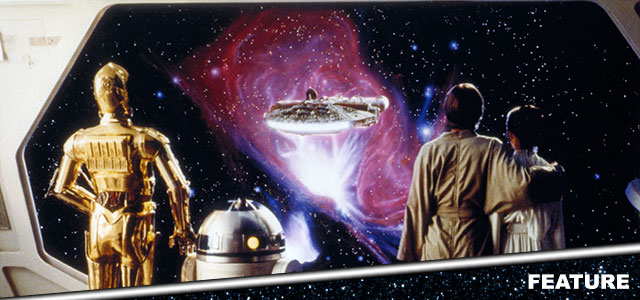
In anticipation of Star Wars: The Rise of Skywalker's release this December, we're counting down all the Star Wars movies in chronological order of release.
This week, we're looking at what many consider to be the greatest movie in the series: The Empire Strikes Back.
What's the story of Star Wars: Episode V - The Empire Strikes Back?
A long time ago, in a galaxy far, far away, an intergalactic war continues to rage between the evil Empire and the rebel alliance.
Following the destruction of the Death Star, the rebels have set up base on the ice planet of Hoth. Faced with the encroaching forces of Darth Vader (David Prowse), our heroes splinter. Luke Skywalker (Mark Hamill) is urged to seek out wise Jedi master Yoda (Frank Oz) on the planet of Dagobah in order to complete his training.
Meanwhile, Han Solo (Harrison Ford), Leia (Carrie Fisher), Chewbacca (Peter Mayhew), C-3PO (Anthony Daniels) and R2-D2 (Kenny Baker) are forced to flee the Empire's forces on the crippled Millennium Falcon. They seek refuge with Han's old smuggling cohort – and former Falcon owner – Lando Calrissian (Billy Dee Williams) on Bespin Cloud City.
Luke, meanwhile, is drawn inexorably towards his first conflict with Vader – which results in a terrifying revelation that will change his life forever.
How did The Empire Strikes Back get made?
Released in 1977, Star Wars, later retitled Episode IV: A New Hope, was a landmark moment in pop culture history. Writer-director George Lucas's loving and spirited tribute to the space opera serials of his youth defied its troubled production to become the biggest movie of all time.
Through a combination of old-fashioned, nostalgic storytelling, clever marketing and merchandising and John Williams's magnificently operatic score, A New Hope revitalised the kind of epic Hollywood storytelling that had largely fallen out of favour by the mid-seventies.
The movie won four Oscars and although people weren't to know at the time, opened the doors to a new era of blockbuster film-making where popcorn and visual spectacle went hand in hand to secure the biggest possible audience. In tandem with Steven Spielberg's earlier Jaws (1975), A New Hope was, in retrospect, the end of an era of experimental film-making and the advent of a new era in which commercial values took precedence.
However, it wasn't without cost. Lucas was so troubled and wrung-out by the making of A New Hope – everything from fights with the producers to disruptive on-location weather – that he stepped back from the making of the next instalment.
Not that it mattered: unbeknownst to distributor 20th Century Fox, they had cut a deal with Lucas over sequel and merchandising rights that granted him unprecedented creative control in the wake of A New Hope's enormous financial success. Lucas was to become more a businessman overseeing the franchise from the sidelines rather than a key creative force behind the camera (although he would later return to direct the prequel trilogy).
However, Lucas was involved in the hiring of key creatives on the new movie, to be titled The Empire Strikes Back. He picked Irvin Kershner for the role of director (who initially turned it down out of fear he wouldn't be able to top A New Hope) – Kershner was famous for directing character-driven thrillers Raid on Entebbe (1977) and The Eyes of Laura Mars (1978). There were also personal reasons for Kershner's hiring: he was one of Lucas's former professors at the USC School of Cinematic Arts.
Lucas also got science-fiction writer Leigh Brackett on board to write the screenplay. Having turned in her first draft in 1978 (with which Lucas was reportedly disappointed), Brackett died of cancer not long after. Mulling over the possible directions in which the plot could go, Lucas hit on the idea of making ruthless Darth Vader, formerly Anakin Skywalker, the father of Luke Skywalker.
From here, Anakin's tragic backstory grew, including his training by Obi-Wan Kenobi (Alec Guinness) and eventual seduction by the dark side of the Force. Lucas then decided to make Empire the middle movie of a second Star Wars trilogy, mapping out the first as the story of how Anakin turned into Darth Vader.
The outline in place, Lucas then hired screenwriter Lawrence Kasdan, who had recently completed the script for Lucas and Spielberg's eventual hit Raiders of the Lost Ark (1981). Kasdan worked with Kershner and producer Gary Kurtz to flesh out the various drafts, in the process helping to shape what would become the darkest and most dramatically engrossing entry in the series.
As with A New Hope, The Empire Strikes Back forged exciting new ground in the realm of special effects. Company Industrial Light and Magic, formed by Lucas specifically to handle A New Hope's challenging action sequences, once again led the way, emboldened by the financial success of the earlier film.
In addition to ILM's pioneering work, Empire also featured ground-breaking stop-motion effects (whereby footage is advanced one frame at a time to create the illusion of movement). The work of animator Phil Tippett became especially apparent in the early sequences on the icy planet of Hoth, particularly with creatures the Tauntauns and the exciting aerial battle on the Empire's At-At walkers.
The film's most famous instance of puppeteering is, of course, Yoda. The wizened old Jedi warrior was instantly cemented as a Star Wars favourite, largely due to Frank Oz's distinctive vocal delivery and the puppet's charming physical appearance. Make-up artist Stuart Freeborn combined his own features with that of Albert Einstein to invest the character with profound life and wisdom.
A Norwegian glacier acted as the location for Hoth, where the crew encountered the worst winter storm in 50 years. Production was no less tricky when it relocated to the spiritual Star Wars home of Elstree Studios in London. During the filming of the Dagobah sequences, actor Mark Hamill became disillusioned with the lack of contact with other human actors.
The Dagobah sets were suspended five feet above the floor, allowing puppeteers to animate Yoda from beneath, although this presented problems for voice actor Frank Oz who couldn't hear directions from the crew above.
In total, over 60 sets were built for The Empire Strikes Back, more than double the number for A New Hope. The budget was also considerably larger at $22 million (when factoring in budget over-runs, A New Hope cost $11 million). Additional problems included a fire on Stage Three at Elstree, which had also been used for Stanley Kubrick's classic horror The Shining.
Many important new characters were introduced, ones set to exert an impact over the later movies. In addition to Yoda, we also got a brief holographic glimpse of Emperor Palpatine, Vader's master, although not portrayed by actor Ian McDiarmid in this iteration (he was voiced by Clive Revill and played by Marjorie Eaton while wearing a mask).
Equally significant was Billy Dee Williams as Lando Calrissian, an important character for how he fleshes out Han Solo's backstory. (This was explored to its fullest extent in 2018 prequel movie Solo: A Star Wars Story, in which he's portrayed by Donald Glover.) His betrayal of Han remains one of the franchise's most upsetting moments, although Calrissian ultimately redeems himself.
A key player in Solo's portrayal is masked bounty hunter Boba Fett, portrayed by Jeremy Bulloch. Despite having next-to-no lines, Bulloch's imposing physical presence made him a fan-favourite – all the more disappointing that he was unceremoniously killed at the start of the next movie, Return of the Jedi.
Kershner allowed improvisation among the actors: Han Solo's famous "I know" response to Leia's "I love you" only came about after multiple takes, during which time Ford had become frustrated over his characterisation. (The rogueish Solo was originally to have replied with the far more sentimental "I love you too" – little wonder Ford had trouble investing in the scene.)
The most infamous aspect of The Empire Strikes Back remains the revelation surrounding Luke's parentage. In order to put people off the scent, Darth Vader actor David Prowse (later to be dubbed, as per the previous film, by James Earl Jones), and indeed the rest of the crew, was given a false script page indicating that Obi-Wan had killed Luke's father.
Immediately prior to shooting the scene, Hamill was informed by director Kershner that Vader was Luke's father – something only the two of them and George Lucas knew about. Hamill was sworn to secrecy, which resulted in a hilarious response from Harrison Ford 18 months later at the premiere.
During production, Lucas was forced to contend with various political wrangles. By the time The Empire Strikes Back was released, Lucas had established his own company Lucasfilm, which preceded the opening crawl at the start of the film.
When it came to the sequel, Lucas demanded that the writer and director credits be relegated to the end, as per A New Hope. The Writers and Directors guilds of America had no problem allowing it on the previous movie because the writer-director credit matched the company name.
However, it was an issue on The Empire Strikes Back because the various guilds viewed the company credit (Lucasfilm) as displaying Lucas' name at the start of the film, while the director and writers had theirs on the end.
The guilds fined Lucas over $250,000 and attempted to pull Empire out of theatres. The DGA also attacked Kershner; to protect his director, Lucas paid all the fines to the guilds. Due to the controversy, he left the Directors and Writers guilds, and the Motion Picture Association.
As the budget swelled by a further $3 million, Lucas was forced to cut a deal with 20th Century Fox in order to secure the loan that his bank was threatening to withdraw. However, he refused to give up the lucrative sequel and merchandising rights in the process – following the movie's release, a great deal of acrimony caused Fox President Alan Ladd Jr., one of Lucas's key allies in the making of A New Hope, to quit.
As a result, Lucas took production of then-in-development Raiders of the Lost Ark to rival studio Paramount.
- Star Wars: The Rise of Skywalker – 6 possible theories as to the meaning of its title
- 8 things we already know about Star Wars: The Rise of Skywalker
- Everything you need to know about the Emperor's return in Star Wars: The Rise of Skywalker
How did John Williams compose the score for The Empire Strikes Back?
If A New Hope signalled a new dawn of popcorn film-making, John Williams's accompanying musical score was no less revelatory.
Williams's rousing, symphonic approach flew in the face of seventies soundtrack trends – this was a time when needle drops and scores from pop musicians tended to hold sway. The composer, however, built on the reputation established by his Oscar-winning Jaws, conjuring a full-blooded, thematically driven orchestral tribute to the classic Hollywood adventure scores of the 1940s, such as Erich Wolfgang Korngold's The Sea Hawk.
The Oscar-winning music of Star Wars proved vital in establishing an emotional lifeline to audiences around the world. From the surging brass of the main title (nothing less than an announcement of the adventure to come) to the yearning, melancholy strings of the Force theme, Williams's worked proved enormously influential on the generations of composers to follow.
Between the release of A New Hope in 1977 and The Empire Strikes Back in 1980, Williams had risen to become the most successful and influential Hollywood composer of his day. Expectation was sky-high for The Empire Strikes Back, so what did Williams do? Simple: build on and consolidate the trend-setting approach of A New Hope.
For that reason, the themes of the previous film are present and correct, and they're joined by a host of new ones that prove Williams's astonishing skill in getting to the emotional heart of a movie. The most obvious is of course, The Imperial March – essentially Darth Vader's theme, which carries a decidedly militaristic air and declares the terrifying intentions of the Empire to the audience. This piece would directly influence composer Michael Giacchino's Imperial theme for A New Hope prequel Rogue One: A Star Wars Story (released in 2016).
Elsewhere, we have the tender flute and strings of Han and Leia's love theme, which builds from a tentative start into a fulsome, sincere expression of romance. This is the piece that has been heard throughout the Rise of Skywalker trailers, a sign of how music can re-affirm the legacy of an entire franchise.
Perhaps the most charming and tear-jerking piece in the score is Yoda's Theme, which builds from a seemingly quaint flute solo into a grandiose statement of orchestral power, reinforcing the wisdom of the character. It's little wonder Williams is said to consider this one his favourite musical pieces.
Williams's application of these themes throughout the movie is extraordinary – each piece dances around the other, constructing such an operatic tapestry of emotion and meaning that dialogue often isn't needed. Just take the intimidating blasts of the Imperial March during the pivotal Battle of Hoth cue – across 14 relentless minutes (complete with intelligent nuances like rumbling pianos mirroring the movement of the At-At's), Williams's mastery is evident.
It all resulted in another Oscar nomination for the composer, although no win this time (the Oscar that year went to French composer Georges Delerue for A Little Romance).
What was the legacy of The Empire Strikes Back?
The Empire Strikes Back held its world premiere on 17th May 1980 at Washington DC's Kennedy Centre. This was followed by the Leicester Square Royal Charity premiere on 20th May (dubbed 'Empire Day').
Audiences were caught off-guard by the on-screen title of the film that announced it as Episode V. At the time, they of course had no idea this was the middle part of a second trilogy, and Episode IV was retrospectively added to the opening crawl of A New Hope during its 1981 re-release.
Critics were generally favourable to the movie at the time, although its reputation has increased considerably in the years since. Many fans and reviewers now consider it to be the finest instalment in the trilogy, one that throws shocking revelations at the audience without disrupting narrative flow, and all-the-while expanding our understanding of the characters.
Empire is notable among the Star Wars franchise, and indeed among popcorn blockbusters as a whole, for audaciously allowing the bad guys to win. At the end of the movie, Luke is physically crippled from losing his hand, and emotionally haunted by Vader's taunting revelation.
The movie concludes on a commendably bleak and open-ended note, in which it's unclear how our heroes will emerge from this traumatic ordeal with their bravery intact. It's not hard to imagine the impact this may have had on, for example, Christopher Nolan's The Dark Knight, another audience-pleasing blockbuster epic that allows its main antagonist to win (albeit temporarily – like Star Wars, the third and concluding movie restores a sense of order).
Of course, Empire's biggest impact is on the Star Wars trilogy itself. This is where the series reveals itself as more than just a flimsy space opera, but a darkly compelling story of family ties that has profound implications for the entire galaxy. Thanks to Lucas's ideas and Kershner's steady directorial hand, the groundwork of the later prequel trilogy, not to mention the current trilogy, was set.
The Empire Strikes Back went on to gross $538 million worldwide, some $200 million less than its predecessor. Still, it was a hugely impressive result – there was surely no matching the epochal, lightning in a bottle impact of A New Hope, and the darker Empire also makes greater emotional demands of its audience, as opposed to the previous, happy-go-lucky adventure.
What was the next movie in the Star Wars saga?
Episode VI: Return of the Jedi was the next instalment in the series, released in 1983. Stay tuned to the Cineworld blog for a full breakdown.
When is Star Wars: The Rise of Skywalker released in the UK?
Star Wars: The Rise of Skywalker is released in Cineworld on 19th December. Tweet us your favourite Star Wars moments @Cineworld.
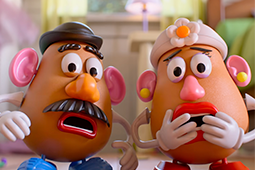
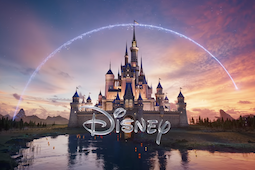
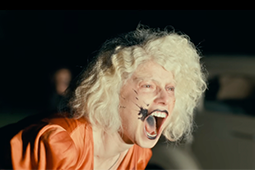

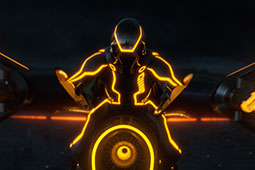

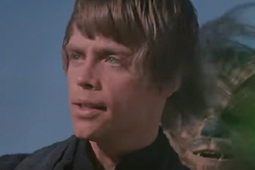

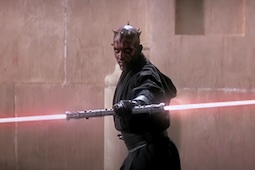
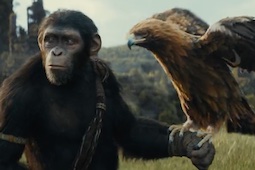
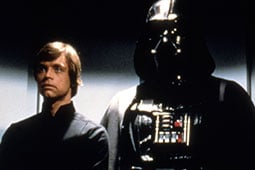


.jpg)
.png)






